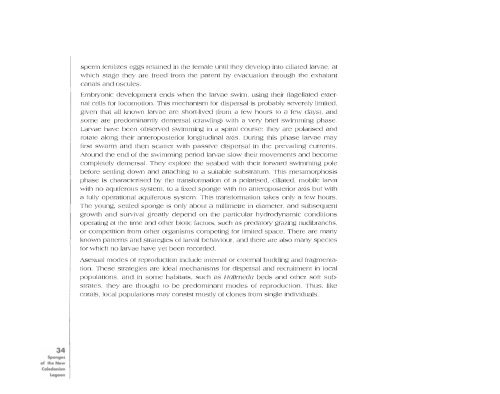Sponges of the New Caledonian lagoon - IRD
Sponges of the New Caledonian lagoon - IRD
Sponges of the New Caledonian lagoon - IRD
You also want an ePaper? Increase the reach of your titles
YUMPU automatically turns print PDFs into web optimized ePapers that Google loves.
34<br />
<strong>Sponges</strong><br />
<strong>of</strong> <strong>the</strong> <strong>New</strong><br />
<strong>Caledonian</strong><br />
Lagoon<br />
sperm fertilizes eggs retained in <strong>the</strong> female until <strong>the</strong>y develop into ciliated larvae, at<br />
which stage <strong>the</strong>y are freed from <strong>the</strong> parent by evacuation through <strong>the</strong> exhalant<br />
canals and oscules.<br />
Embryonic development ends when <strong>the</strong> larvae swim, using <strong>the</strong>ir flagellated external<br />
cells for locomotion. This mechanism for dispersal is probably severely limited,<br />
given that all known larvae are short-lived (from a few hours to a few days), and<br />
some are predominantly demersal (crawling) with a very brief swimming phase.<br />
Larvae have been observed swimming in a spiral course: <strong>the</strong>y are polarised and<br />
rotate along <strong>the</strong>ir anteroposterior longitudinal axis. During this phase larvae may<br />
first swarm and <strong>the</strong>n scatter with passive dispersal in <strong>the</strong> prevailing currents.<br />
Around <strong>the</strong> end <strong>of</strong> <strong>the</strong> swimming period larvae slow <strong>the</strong>ir movements and become<br />
completely demersal. They explore <strong>the</strong> seabed with <strong>the</strong>ir forward swimming pole<br />
before settling down and attaching to a suitable substratum. This metamorphosis<br />
phase is characterised by <strong>the</strong> transformation <strong>of</strong> a polarised, ciliated, mobile larva<br />
with no aquiferous system, to a fixed sponge with no anteroposterior axis but with<br />
a fully operational aquiferous system. This transformation takes only a few hours.<br />
The young, settled sponge is only about a millimetre in diameter, and subsequent<br />
growth and survival greatly depend on <strong>the</strong> particular hydrodynamic conditions<br />
operating at <strong>the</strong> time and o<strong>the</strong>r biotic factors, such as predatory grazing nudibranchs,<br />
or competition from o<strong>the</strong>r organisms competing for limited space. There are many<br />
known patterns and strategies <strong>of</strong> larval behaviour, and <strong>the</strong>re are also many species<br />
for which no larvae have yet been recorded.<br />
Asexual modes <strong>of</strong> reproduction include internal or external budding and fragmentation.<br />
These strategies are ideal mechanisms for dispersal and recruitment in local<br />
populations, and in some habitats, such as HaJimeda beds and o<strong>the</strong>r s<strong>of</strong>t substrates,<br />
<strong>the</strong>y are thought to be predominant modes <strong>of</strong> reproduction. Thus, like<br />
corals, local populations may consist mostly <strong>of</strong> clones from single individuals.

















